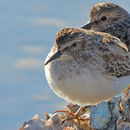en
names in breadcrumbs


One of the smallest sandpipers in the Americas, the Least Sandpiper may be identified by its small size (5-6 ½ inches), short wings, and yellow legs. In summer, this species is mottled brown above with a white belly, streaked breast and throat, and pale white eye-stripes. In winter, the Least Sandpiper becomes darker and duller than in summer. Males and females are similar to one another in all seasons. The Least Sandpiper has one of the southernmost breeding ranges of all North American sandpipers. This species breeds from the high arctic south to Nova Scotia and British Columbia and from Alaska east to Newfoundland. The Least Sandpiper is also one of the most widespread winter sandpipers in North America, wintering along the coast from Oregon and New Jersey south to Central America and the West Indies. This species also winters in northern South America. Least Sandpipers breed in a variety of freshwater habitats, particularly in bogs. During the winter, this species may be found in freshwater and saltwater along beaches, lagoons, estuaries, and other wet habitats near bodies of water. Least Sandpipers feed primarily on small mud-dwelling invertebrates. Least Sandpipers are most easily observed along the water’s edge, probing the mud for food with their bills. They may also be seen in small flocks flying above the surf, frequently mingling with other species of waders. This species is most active during the day.
One of the smallest sandpipers in the Americas, the Least Sandpiper may be identified by its small size (5-6 ½ inches), short wings, and yellow legs. In summer, this species is mottled brown above with a white belly, streaked breast and throat, and pale white eye-stripes. In winter, the Least Sandpiper becomes darker and duller than in summer. Males and females are similar to one another in all seasons. The Least Sandpiper has one of the southernmost breeding ranges of all North American sandpipers. This species breeds from the high arctic south to Nova Scotia and British Columbia and from Alaska east to Newfoundland. The Least Sandpiper is also one of the most widespread winter sandpipers in North America, wintering along the coast from Oregon and New Jersey south to Central America and the West Indies. This species also winters in northern South America. Least Sandpipers breed in a variety of freshwater habitats, particularly in bogs. During the winter, this species may be found in freshwater and saltwater along beaches, lagoons, estuaries, and other wet habitats near bodies of water. Least Sandpipers feed primarily on small mud-dwelling invertebrates. Least Sandpipers are most easily observed along the water’s edge, probing the mud for food with their bills. They may also be seen in small flocks flying above the surf, frequently mingling with other species of waders. This species is most active during the day.
The least sandpiper (Calidris minutilla) is the smallest shorebird. The genus name is from Ancient Greek kalidris or skalidris, a term used by Aristotle for some grey-colored waterside birds. The specific minutilla is Medieval Latin for "very small".[2]
This species has greenish legs and a short, thin, dark bill. Breeding adults are brown with dark brown streaks on top and white underneath. They have a light line above the eye and a dark crown. In winter, Least sandpipers are grey above. The juveniles are brightly patterned above with rufous coloration and white mantle stripes.
This bird can be difficult to distinguish from other similar tiny shorebirds; these are known collectively as "peeps" or "stints". In particular, least sandpiper is very similar to its Asian counterpart, long-toed stint. It differs from that species in its more compact, shorter-necked appearance, shorter toes, somewhat duller colors, and stronger wingbar.
Measurements:[3]
Their breeding habitat is the northern North American continent on tundra or in bogs. They nest on the ground near water. The female lays four eggs in a shallow scrape lined with grass and moss. Both parents incubate; the female leaves before the young birds fledge and sometimes before the eggs hatch. The young birds feed themselves and are able to fly within two weeks of birth.
They migrate in flocks to the southern United States, Mexico, Central America, the Caribbean, and northern South America. They occur as very rare vagrants in western Europe.[4]
These birds forage on mudflats, picking up food by sight, sometimes by probing. They mainly eat small crustaceans, insects, and snails.
{{cite book}}: CS1 maint: unfit URL (link) The least sandpiper (Calidris minutilla) is the smallest shorebird. The genus name is from Ancient Greek kalidris or skalidris, a term used by Aristotle for some grey-colored waterside birds. The specific minutilla is Medieval Latin for "very small".